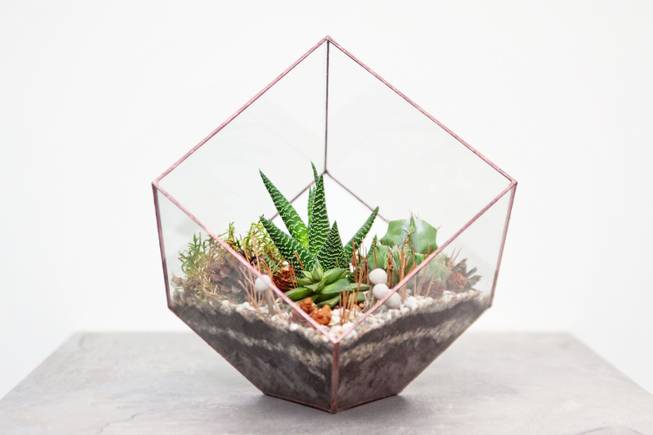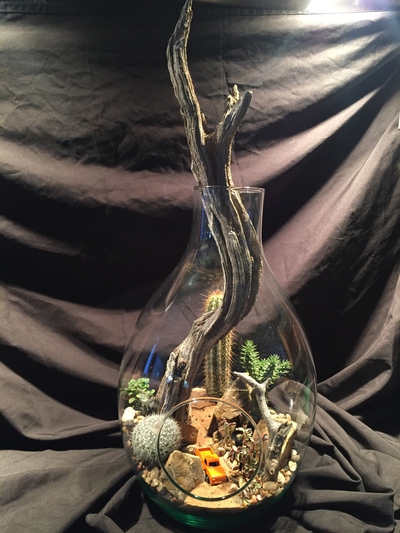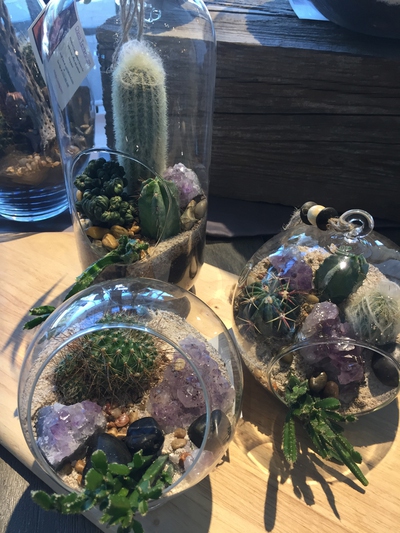
Shutterstock.com
Sunday, July 9, 2017 | 2 a.m.
No one can say exactly why things go in and out of fashion. But there’s no denying that terrariums are back.
The little glass universes filled with living ferns, succulents, cacti or gems, totems, rocks and found wood, are seemingly omnipresent. They catch your eye dangling from windows at big chains like Pottery Barn and West Elm as well as small shops and boutiques throughout the valley. Their greens, golds and browns peep from the corners of chic living rooms and stylish cafes. They offer a low-maintenance way to bring the outside inside, but a terrarium that’s as sustainable as it is beautiful isn’t so straightforward. We did our homework and talked to expert terrarium crafter Tom Gerbracht of Oasis Gardens to get you creating a teensy realm all your own.
How to make and maintain your own
Looking closely at Gerbracht’s creations makes it obvious that he sweats the details: one features a little vintage truck apparently off-roading in a desert of cacti and rocks, the tiny tires leaving tracks in the sand behind it. Another features a peaceful Buddha meditating among lush succulents. “Terrariums can be different things for different people,” he explains. “For some, they really are mediation spaces, a little world to escape into on your desk, or maybe just a touch of whimsy in an otherwise serious world.”
Whatever role your terrarium plays in your life, keeping it alive is key. Gerbracht has a few rules of thumb he never strays from in order to make sure his creations flourish in our dry climate. Pick a glass container with a shape you love, and go from there.
BASE
1 inch aquarium gravel for drainage + 1 inch activated charcoal to keep soil fresh + 2 inches quality potting soil cut with sand to mimic the desert.
LAYOUT
Arrange larger elements in the soil, reserving accents to place once the greenery is in. Then plant the way you would in a garden, for balance and contrast.
PLANTS
Select species that need little water and do well in low or indirect light. Smaller is best, so they’re not constrained by the walls of their glass vessel.
CUSTOMIZE
Once you’ve mastered the standard, try holiday designs: for example, a Mason jar layered with rocks, moss and mini Easter eggs with a colorful topper is a great table display.
• Start from the bottom up. “Line the base of your terrarium with a bit of gravel, enough so if given the right amount of water, evaporation will occur.” In other words, your plant’s roots should never be sitting in water, and (bonus) you shouldn’t need to drain your terrarium, either.
• Love, don’t smother. “Cacti and succulents need an open terrarium, whereas covered cases are for tropical plants that need the constant condensation.”
• Choose the right plants. “In our climate, unsurprisingly, cacti work best, but succulents also do quite well. A variety in height, shape, texture and color keep things interesting, too.” If you end up killing one in your rookie phase, local grocery stores sell cacti and succulents for a few dollars, so you can fill in the gap with a new face.
• Avoid direct sunlight. “Inside or outside makes no difference so long as the plants are not subjected to the sun’s rays directly.”
• One straw does it all. “A good rule to stick to is to use a straw to water for each plant in your piece. This way you can provide one straw per plant per week, backing off to every other week in the winter. Plus, you keep your glass clean by avoiding spritzing.”
• Make it your own. Gerbracht’s designs always offer a surprise in the form of a totem, whether it’s a painted plastic figurine that looks like your dog or a hand-carved stone tortoise imported from Peru. He might add statement crystals or smooth, polished stones that complement the background. Even if you buy a piece made by someone else, feel free to add a special rock or toy picked up on your travels or given to you by a loved one.
Who invented the terrarium?
First built as a solution to protecting greenery from the toxic air of 19-century London, the terrarium came into being with a tiny fanbase: horticulturalists. An English doctor and amateur botanist, Nathaniel Bagshaw Ward, came up with a way to transplant exotic species and what became household ferns without killing them. As terrariums, or Wardian cases, became more popular, they became more elaborate, making a rapid transition from pragmatic invention to emblem of personal style.
Tom Gerbracht remembers how popular they were in the 1970s. “When I was 10, it seemed like everyone was making them as a hobby,” Gerbracht recounts, “so my aunts taught me a few things because it was one of their favorite activities.”
Five years ago, Gerbracht picked up the hobby all over again when he spotted a terrarium for sale at a Los Angeles flea market. “I bought it, and right away I started making them on my own, eventually deciding to take my rediscovered hobby further.”
Further became Oasis Gardens, the terrarium business he took from area farmers markets to downtown’s First Friday. His little ecosystems are growing in popularity such that soon, a permanent space will house the business at Charleston Boulevard and 10th Street in the Charleston Bazar Shopping Center. Although the bulk of the business will focus on flowers, terrariums will have a presence both in the shop’s slated how-to classes (to be offered the third Saturday of every month) and on the sale floor.



Join the Discussion:
Check this out for a full explanation of our conversion to the LiveFyre commenting system and instructions on how to sign up for an account.
Full comments policy